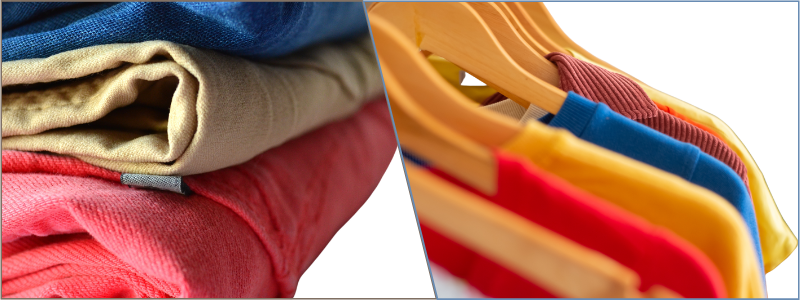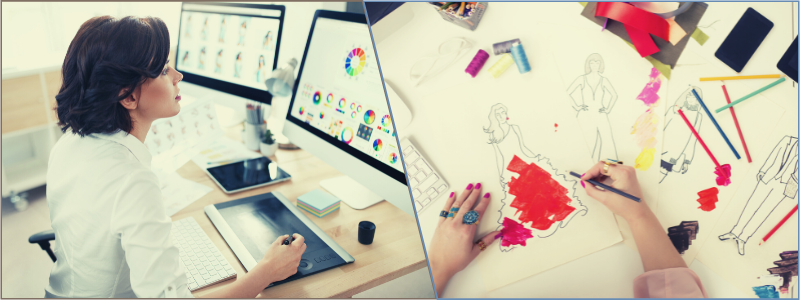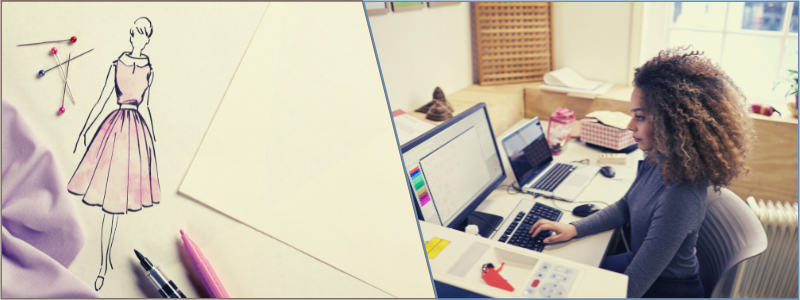In this article, we tell you more about clothing 3D rendering services costs and processes. The production process of a clothing item follows the same sequence as any product in most industries. It goes from an idea to a concept/sketch before the drawing is transformed into a computer-aided design (CAD) file and sent to a prototype maker. Once a sample is manufactured, the designer evaluates the clothing to see whether everything is made in accordance with the specification attached to the CAD design. Revisions are made as many times as necessary.
 Table of contents
Table of contents
A clothing specification or datasheet is called a “tech pack,” which contains details about a specific prototype design written/drawn by a designer for a manufacturer. Think of it as a blueprint based on which a manufacturer creates a finished garment. A tech pack must include a set of technical drawings to showcase the front and back views of the overall design along with close-up diagrams of clothing components such as stitching details, pockets, seams, labels, pleats, zippers, and buttons, to name a few. The data sheet must also specify the materials, compositions, dimension (including weight), colorways, quantity, and order information.
RELATED: How 3D modeling services are changing the fashion industry
The technical drawings in a tech pack usually are flat sketches with annotations. What if you use a 3D rendering of the clothing article instead of a two-dimensional diagram? It would make an excellent visualization of the design, but a 3D rendering service does not come cheap.

3D rendering & modeling costs
A visualization studio charges between $50 and $600 to create a product 3D rendering design. You get what you pay for, which means you should get better quality work as you move closer to the higher end of the price range. There are few studios (or individual render artists) willing to take the project for under $50, but you can certainly find many that charge more than $600.
Visualization studios based in the United States, the United Kingdom, Canada, and western European countries will be more expensive than those in China and India, partly thanks to the differences in the labor cost, but unfortunately, it may have something to do with the work quality as well.
RELATED: How much does 3D product rendering cost for a new product design?
At the bare minimum, expect to pay no less than $99 for a 3D rendering design of a single clothing article. Prices increase as the product gets more complex.
| Product Type | Typical Examples | 3D Rendering Cost | Colorway Cost |
| Basics | Shorts, tights, and t-shirts | From $99 | $99 |
| Fast Fashion | Shirts, pants, dresses, polo | From $149 | $99 |
| Techwear and Tailored | Outdoor clothing, jackets, sportswear | From $349 | $99 |
Colorway cost applies to each variation.
Clothing 3D rendering process
There is no major difference in the 3D visualization design process between a piece of clothing and any other type of product. A typical sequence of progress is outlined below:
The client’s vision
The client and a render artist engage in a discussion about the project. The latter has to understand what the former needs before the work begins. The client must provide every detail about the clothing, much like in a tech pack; two or more rough sketches of the product (with annotation for dimension) should help a great deal.
RELATED: 3D Rendering vs. photography: how photorealistic 3D modeling can help your company
3D modeling
The rendering artist uses computer-aided design (CAD) software to create the visualization based on reference images and information provided by the client. A render artist may purchase a ready-made base model from a 3D asset marketplace and then modify the image as needed or build everything from scratch. Clothing components, such as buttons and zippers, must be included in the 3D modeling design too.
Material and texture
The hallmark of a good rendering is photorealism. A 3D render is regarded as high quality if it looks like a professional photograph. The process is analogous to an architectural 3D rendering service, in which proper visualization requires the right choices of (digital) materials, colors, textures, and patterns applied to the surface. The goal is to make the model as realistic as possible.

Lighting
Light intensity and direction relative to the object affect how the human eyes perceive it. Even if the visualization uses a plain black or white background, the clothing itself (its materials, colors, patterns, and components) inevitably triggers either reflection or refraction in certain directions to affect how it looks in the real world – it is the ultimate purpose of 3D rendering.
RELATED: 3D modeling vs. 3D rendering Services
Once the 3D model is ready and all the parameters are set to the client’s preferences, the render artist generates a two-dimensional image from the model. As simple as it may sound, the process can take several minutes to days, depending on the level of details generated. Rendering is a hardware-demanding process; some visualization studios use a render farm to get it done quickly.
Rendering is done at least twice. The first render is a low-quality draft for the client’s review. If revisions are necessary, the artist makes some changes for final approval. The second render comes after the revisions to deliver the final image.
Why 3D rendering
When used in a tech pack, 3D rendering acts as a production manual. The photorealism effect makes the design clearly understandable in terms of colors, patterns, textures, and materials. A combination of photorealistic image designs and comprehensive descriptions reduces the chance of mistakes during prototype productions. The first prototype may still require a few tweaking, but they should be mostly minor issues.
RELATED: 3D rendering: what it is and why you should care
The digital file will remain in the collection without taking up space in the warehouse. A company may refer back to previous renders and reuse the file for the next product line. All the 3D models used in the rendering can be modified, reshaped, or altered in any manner to make the new collection distinctive enough from the existing ones. The designer doesn’t have to work from scratch for every product release. Product development time shortens, product cost decreases, and profitability improves.
In the marketing department, 3D rendering is most likely more time and cost-efficient than photography in the long run. The reusability and modifiability of the 3D model design allow the company to design the next marketing content from a single screen to create different colors, backgrounds, and complementary items in the frame.
CAD design and 3D technology for product invention
CAD and 3D technology, in general, are the core of many product inventions. Based on a high-quality 3D model, companies can plan and build not only great products but also effective marketing materials in the forms of photos, videos, and interactive content with virtual/augmented reality. In the fashion industry, a company can use the same 3D rendering of clothing as a reference image in a tech pack and a product image on websites or social platforms too.
RELATED: CAD design and 3D modeling rundown
At the same time, the fashion industry is known for its resistance to change. When it comes to 3D, the industry displays an apparent reluctance to adopt the technology, except for a few established international brands. It is quite of a shock considering the fact that the target market is essentially every single person in the world, of course, at different price brackets.
A good majority of the existing 3D technology adoption is on the marketing aspect of the business but rarely touches the manufacturing side of it. Both 3D modeling and rendering are disruptive in every good sense of the word. Much like in the automotive or electronics industry, digital ideation shakes the very foundation of product design services and development processes at its core. It cuts down the time required to complete a design and increases cost efficiency.

There is no need to create dozens of prototypes to get the design right for mass production; it takes one properly-crafted 3D model for the manufacturer to deliver an identical sample. As the business aims for environmental sustainability, a digital repository – represented by a set of 3D modeling and rendering of various product lines – is more eco-friendly than a physical collection. It is not a new paradigm in consumer products elsewhere, but for now, it remains a novelty in the fashion industry.
RELATED: How-to guide: new product design, engineering and prototyping your idea for mass manufacturing
Obstacles of clothing 3D rendering
The biggest challenge in the endeavor is achieving a good level of photorealism for fabrics. A 3D rendering service for a clothing article must convey not only the colors and shapes of the physical product but also its depth and patterns even when (or especially when) a customer magnifies the view on screen. Unlike other materials like metals or plastic, which basically have smooth, rough, reflective, or mirror-like finishes, a piece of fabric is often comprised of multiple materials, knitted or woven fibers. A sheet of fabric may consist of multiple types of fiber, including nylon, cotton, wool, silk, and other threads. A clothing article is sometimes made using a variety of fabrics.
True-to-nature textures are difficult to replicate on a computer screen. In many cases, a render artist has to purchase an assortment of 3D assets (fabrics with specific patterns, pearl-colored buttons, linen blends, etc.) for a project. Such assets are not exactly available in abundance as opposed to metal or wood textures. Many fashion brands keep the 3D assets as proprietary properties.
While there are many options of CAD software a render artist can use, one of the most frequently used is Autodesk’s 3ds Max with V-Ray Render Engine and After Effects. Some professionals also use the ACES (Academy Color Encoding System, developed by the Academy of Motion Picture Arts and Sciences) workflow. In addition to creating photorealism, a 3D modeling project has to aim for modifiability too. It may require more investment of time and money initially, but the finished models and renders can be adjusted and modified for future collections.
How Cad Crowd can help
If you have sketches that you’d like to turn into 3D models, Cad Crowd can connect you with CAD freelancers who are experts in the field. Our top-of-the-line designers can make you a model that’s ready for manufacturing, regardless of if you’re using 3D printing or traditional manufacturing. Whether you’re designing clothing, accessories, or jewelry, our 3D modelers will help you bring your vision to life. Get a quote now.
